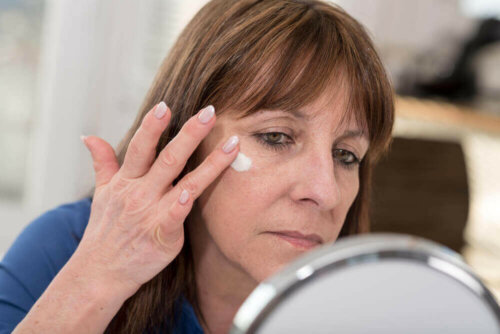How to Read and Understand Cosmetic Labels

Cosmetic labels are an important part of this kind of product so you should pay attention to them when purchasing cosmetics. This is because they contain information about the ingredients, the benefits offered, and indications for use. All of these are key for a consumer to be well-informed, so keep reading and find out what to look for.
The skin is a tissue that can absorb the various substances present in cosmetics. The problem arises when these are toxic chemicals that are harmful in the long term.
What’s a cosmetic?
To better understand labels, let’s first delve into the question of what we consider a cosmetic. In this respect, we’re referring to substances we’re to apply to superficial parts of the body to protect, cleansing, or conceal natural body odor. However, it varies from country to country.
Thus, lotions, deodorants, perfumes, and makeup are all part of the long list that comprises this category of products. Read on and learn what to look for on cosmetic labels.
What’s the INCI and what does it have to do with cosmetic labels?
The INCI (International Nomenclature of Cosmetic Ingredients) is a system that regulates the terminology used in cosmetics. That is for labeling ingredients on the packaging.
In some cases, the Latin names of the ingredients appear in their scientific term and those of the derivatives or chemical ingredients in English. Likewise, they arrange the components in a way that the first ones are those the product contains in greater quantity.

What information should cosmetic labels contain?
Cosmetic labels aren’t usually easy to read; however, you need to know the legal basics. To begin with, they must contain a list of ingredients and present them in descending order of concentration.
In addition, this list must include substances such as allergens capable of producing reactions in sensitive people. Even so, those in a concentration of less than 1 % might be listed in no particular order.
The asterisk is another point to understand on the cosmetic labels. It’s there to either specify the origin of the ingredient or to indicate allergens in the formulation.
The FDA includes information such as company name and address, precautions for use, product function, weight or volume of contents, instructions for use, expiration date, shelf life, and batch number.
Do you ever wonder whether Cosmetics Can Irritate the Skin?
List of ingredients on cosmetic labels
Many ingredients that confer great benefits and are essential to the composition of the formula are added in small quantities. They’re not on the top of the list but you must be able to recognize them. Preservatives and perfumes are there in smaller quantities, below 1%.
Here’s a selection of some of the main components that can affect health in general.
- 1,4-dioxane is in products that generate foam and is toxic
- Benzophenone is a substance used in lipsticks and nail polishes to protect them from ultraviolet rays
- Butylated compounds disrupt endocrine production and are toxic to some organs
- Coal tar is a carcinogen sometimes present in shampoos, soaps, and hair dyes
- Ethanolamine compounds (DEA) are chemicals present in cosmetics and are currently banned in some countries due to possible links with the formation of carcinogenic nitrosamines
- Formaldehyde is a substance released by the preservatives contained in most shampoo and liquid baby soaps
- Triclosan is present in detergents and toothpaste
- Titanium dioxide is a possible carcinogen present in loose make-up powders
- Nitrosamines can appear in a wide range of cosmetics
- Phthalates, banned in some countries, are substances present in products such as scented lotions and soaps
Other information on cosmetic labels
There are some inscriptions on cosmetic labels you should be aware of to know what they refer to. Here are the most relevant ones.
Cruelty-free
As the name implies, the term refers to the fact that the company didn’t test their product on animals. This message may even be endorsed by a certification from a control organization.
Find out How to Identify Quality Cosmetics
Hypoallergenic
This label indicates the formula has a composition that produces fewer allergic reactions. However, there’s no absolute certainty that the product won’t cause any skin problems.

Expiration date
This is the range of time in which you should use the product, taking into account proper storage. Spoilage could happen faster otherwise.
Labels must indicate the maximum period of consumption and, in many cases, this date is there along with the letter “M” accompanied by a figure, i.e. the number of months you can use it.
The information on cosmetic labels
The cosmetics industry is one of the fastest-growing markets and this has led manufacturers to display a greater degree of transparency in their formulas and labels. In turn, ingredients are becoming a relevant issue for consumers, who are better informed and pay more attention to what they consume.
All cited sources were thoroughly reviewed by our team to ensure their quality, reliability, currency, and validity. The bibliography of this article was considered reliable and of academic or scientific accuracy.
- C. Laguna, J. de la Cuadra, B. Martín-González, V. Zaragoza, L. Martínez-Casimiro, V. Alegre. Dermatitis alérgica de contacto por cosméticos. Actas Dermo-Sifiliográficas [Internet] 2009 [consultado 16 de marzo de 2021]; volumen (100): páginas 50-60. Disponible en:https://www.sciencedirect.com/science/article/abs/pii/S0001731009700572
- Marta e Ignacio Suay Matallana. Título Nombrar los cosméticos:los orígenes y consolidación de la nomenclatura cosmética internacional. Real Acad Farm [Internet] 2020 [consultado]; volumen (86): páginas pp. 179 – 186. Disponible en:https://analesranf.com/articulo/8603_03/
This text is provided for informational purposes only and does not replace consultation with a professional. If in doubt, consult your specialist.








